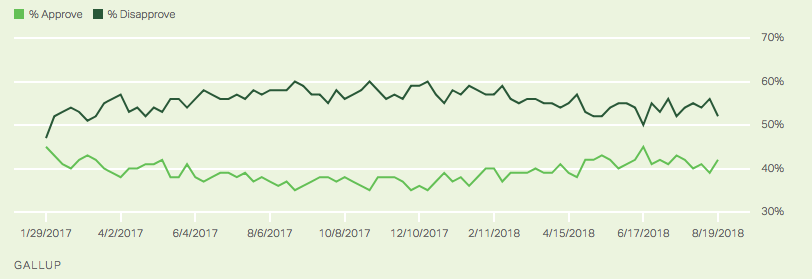News that President Trump’s former lawyer Michael Cohen pled guilty to violating campaign finance laws by paying hush money to women at the direction of Trump has reignited the debate over impeachment.
There are several different questions related to the topic of impeachment, including whether any of Trump’s actions, if proven, rise to the level of an impeachable offense — and whether Democrats will emerge from the midterms with enough seats in Congress to impeach. Both are worthy of debate.
But there is also another layer to all of this, which is the political reality that even if they have the power, Democrats will have a difficult time impeaching Trump if they lack the popular support for doing so. And as of now, the public is simply not clamoring for impeachment.
[Nancy Pelosi: Impeaching Trump still ‘not a priority’ for Democrats]
Before moving on, I should note that there hasn’t been any polling conducted after Tuesday’s Cohen news (along with conviction of former campaign manager Paul Manafort). If this news dramatically affects polling, obviously, that would alter this analysis. But until that time, it’s worth keeping in mind that as demonstrated during the Clinton era, if a majority party takes the major step of impeaching a president without significant public support, it can backfire politically.
None of the polling done on the impeachment issue has shown strong support for removing Trump, and what’s more, his approval ratings, while relatively low, have been quite consistent throughout his presidency.
Specifically, a July Quinnipiac poll found that just 39 percent of Americans would want Democrats to impeach Trump if they took over the House of Representatives, compared to 55 percent who said they would not. A June CNN poll, found 42 percent support for impeachment, compared to 51 percent opposition. In the CNN poll, whereas 77 percent of Democrats favored impeachment, just 38 percent of independents said they did. Unless those numbers change dramatically, any impeachment push by Democrats is likely to be seen as a partisan effort to embarrass the president.
By comparison, in the days before Richard Nixon was forced to resign from office in August 1974, two-thirds of Americans had supported impeachment versus just 27 percent who opposed it.
It’s also instructive to look at approval ratings. Though polls have shown Trump to be generally unpopular, his approval ratings have been quite stable and have not come close to Nixon levels. Trump was more polarizing than any other president at the start of his time in office, and basically had no honeymoon. His first week in office in January 2017, his approval rating peaked at 45 percent and was down to 41 percent within two weeks. In the latest weekly Gallup numbers for mid-August, Trump was at 42 percent approval. So basically, after all the news cycles and craziness and various revelations over the past year and a half, Trump is more or less where he started (and this holds true if you break numbers down for party identification). He has spent most of his presidency somewhere in the high 30s or low 40s.
[Dershowitz: Trump safe from impeachment so far]

In contrast, Nixon’s approval rating had been in the cellar for months leading up to his resignation. His approval rating never emerged from the 20s at any point after December 1973 and hadn’t hit 40 percent since June 1973.
Of course, it’s theoretically possible that news could come out that would change this dynamic, and drive public opinion regarding Trump and impeachment into Nixon territory. But we’re a long, long, way from that happening.
Barring something extraordinary, Democrats are going to have a hard time winning Republican support, and they need 67 senate votes to remove Trump from office. So, aside from placating their base, it’s hard to see what Democrats would gain by impeachment that couldn’t be gained by using their power of oversight to hold hearings, subpoena documents and witnesses, and keep up the pressure on Trump going into the 2020 election.

